For centuries, architecture has looked to nature for inspiration. You’ve got the impressive, stalactite-style designs in the Alhambra to the nature-mimicking structure of Delhi’s Lotus Temple and countless others.
These grand designs show how powerful nature can be when inspiring buildings. But in today’s world, just imitating nature isn’t enough anymore.
The climate crisis is looming more significant than ever, and it’s time we rethink how humans and nature interact. Architects are no longer asked simply to create buildings that resemble nature – the real challenge now is to design structures that genuinely engage and interact with the natural world around them.
Around the globe, architects are rediscovering the beauty of building with wood. It’s used everywhere, from homes and schools to hotels, theatres, and supermarkets.
There’s something inherently comforting about wood – maybe it reminds us of time spent outdoors, surrounded by nature. Are architects turning to wood to bring nature-inspired peace and rejuvenation into our everyday spaces?
Triodos Bank’s new office in the Netherlands, seamlessly blended with its surroundings, is a groundbreaking example of large-scale timber construction.
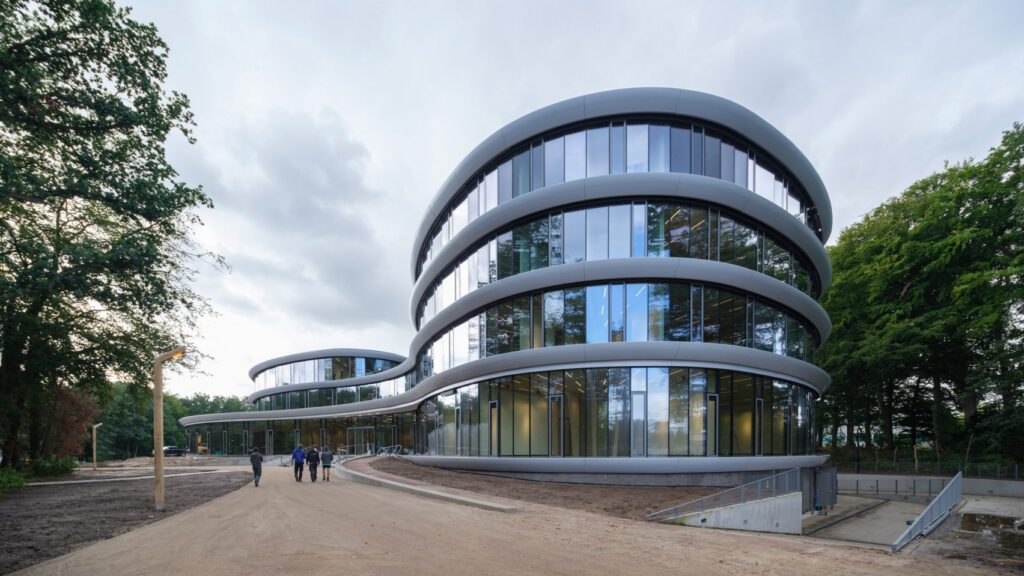
The brainchild of architect Thomas Rau, this impressive building was recently awarded the international BREEAM Award in the Commercial – Post Construction category.
A real team effort, the project was brought to life by EDGE Technologies and Triodos Bank, with design expertise from Ex Interiors and landscape architects Arcadis.
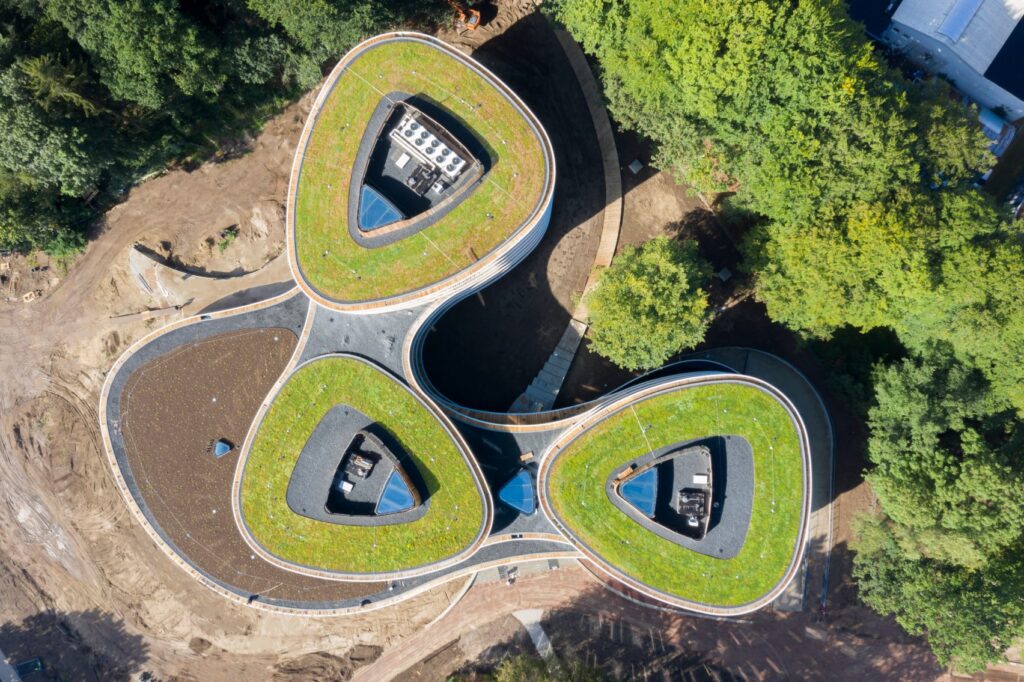
Construction company J.P. van Eesteren joined forces with Derix Group, a timber manufacturer, to create the building’s wooden heart.
This involved using 3,200 square metres of cross-laminated timber (CLT) for the walls and 1,700 square metres of CLT for the floors.
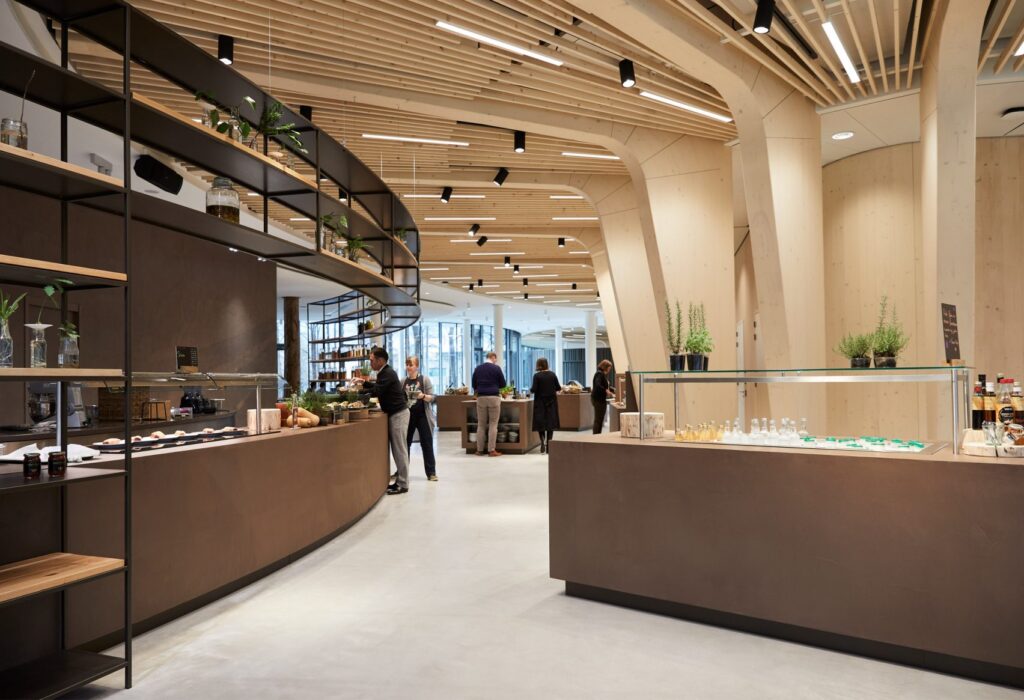
Thanks to an innovative technique known as triple finger jointing, they crafted a structural framework made entirely of timber – a stunning testament to wood’s creative and sustainable potential in construction.
The buildings of the Triodos Bank’s new office are designed with mindfulness for their natural surroundings – they’re crafted to fit in rather than stand out.

The construction carefully matches the height of the local trees, a design choice to avoid disturbing the flight pattern of the area’s bats.

But it’s not just about aesthetics – these buildings’ interiors help deepen the connection with the surrounding De Reehorst estate.
The design is built entirely from sustainable materials and incorporates 2,000 square metres of PEFC-certified timber.
The buildings cleverly use glass to draw in natural light, flooding into the structure’s heart, creating a sense of warmth and openness.
The spacious rooms, teamed with exposed laminated timber trusses, cores, and floors, make a striking contrast against the building’s muted colour palette, proudly showcasing its unique, timber-centric construction.
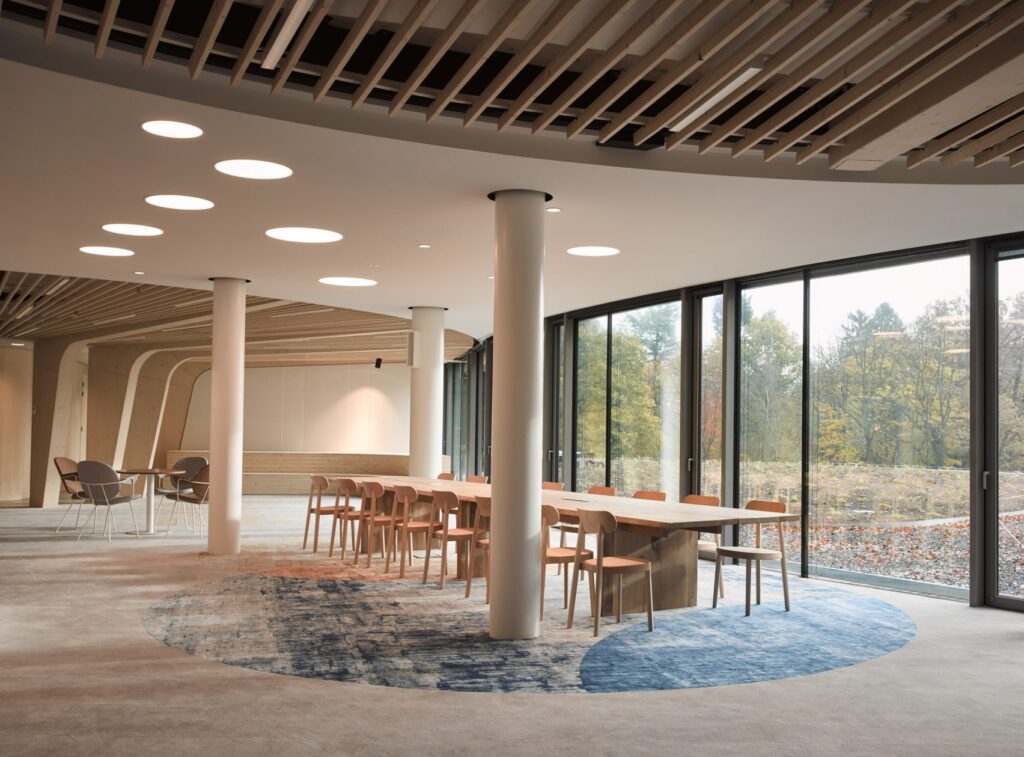
It’s more than a building – a space designed to spark interaction and engagement between employees, visitors, and the public.
But the real question is, does spending time in a structure constructed primarily of wood lead to personal health benefits?
A collaborative study between Stora Enso and the Technical University of Munich uncovered wooden interiors’ health and wellness perks.
The survey, spanning multiple research areas, discovered that wood is easy on the eyes and might also do wonders for our stress levels and productivity.
Findings showed that being in a wooden environment can help lower cortisol, our main stress hormone.
Students were found to be less anxious in classrooms made of wood. But it’s not just about mood – wood also has practical benefits.
It’s excellent at maintaining the right humidity levels, reducing allergens, and even limiting the spread of bacteria and viruses.
And with the world more conscious of cleanliness than ever, another discovery from the study stood out – coronaviruses were found to survive for a much shorter time on wooden surfaces than on other common materials.
Who knew that wood could be so beneficial?
Hoping to inspire further research in this field, Sebastian Hernandez, Building Concepts Manager at Stora Enso Wood Products, said: “Building with wood has many benefits, such as lowering environmental impact – CO2 emissions can be reduced by up to 75% when compared against traditional processes with concrete and steel. But often underappreciated is how it can improve health and wellbeing.”
The role of forest certification
The Programme for the Endorsement of Forest Certification (PEFC) safeguards forests by promoting sustainable forest management through certification.
Forest certification is crucial in providing evidence of sustainable forest management.
It enables forest owners and managers to demonstrate that the practices they apply in the forest today are sustainable and that their forests meet both our needs and those of future generations.
As the demand for certified forest products for building grows, the PEFC is curious about how far the benefits of forests and wood in construction are linked.
In a recent dialogue with PEFC, Juan Miguel Villarroel, the CEO of the Forestry Association of Navarra, shed light on the mutual benefits of our interaction with forests.
Beyond the health benefits we gain from these green spaces, Villarroel emphasized how engaging with forests can stimulate rural employment, creating sustainable jobs centred around forest care and management.
He proposed that our closeness to these lush landscapes can cultivate a sense of environmental responsibility crucial for preserving vital ecosystems.
Forest bathing: spending time in forests to soak up its positive effects
The effects described above have been the basis for Shinrin-yoku, or forest bathing, a concept Japan’s Ministry of Agriculture, Forestry, and Fisheries introduced in 1982. The idea is straightforward: intentionally spend time in forests to soak up their positive effects.
Researchers have begun to quantify the benefits of forest bathing to inform evidence-based medicine.
Their research has shown that being in a forest setting can lower stress hormones, slow heart rate, decrease blood pressure and improve our overall mental well-being.
These health benefits add to the already significant reasons to protect our natural environments and continue to build sustainable ways for the future.
PEFC highlights that wood when responsibly sourced, is an extraordinary building material.
It’s quick to work with, beautifies any project, and doesn’t require as much energy to produce as concrete, steel, cement, or glass.
But it’s not just good for the environment but also for people.
Thanks to its excellent ability to regulate heat and humidity, wooden buildings often need less artificial temperature control, making them comfortable places to be and being kind to the planet.
NTU Singapore: Asia’s Largest Mass Timber Building
Earlier this year, the stunning “Gaia,” a zero-energy mass timber building, was unveiled at Nanyang Technological University (NTU) to bring people closer to nature.
This architectural marvel, the largest mass timber building in Asia and a PEFC-certified project, results from a partnership between RSP Architects and Toyo Ito & Associates Architects.

Spanning a staggering 220 metres, Gaia’s design uses a modular timber frame system.
This innovative twist means that most components can be made off-site, dramatically speeding up the construction process and reducing the number of workers needed.
Gaia is the eighth Nanyang Technological University (NTU) campus project to be honoured with the Green Mark Platinum for zero energy.
It emits about 2,500 fewer tonnes of carbon dioxide in a year than a typical building. Gaia’s environmental achievements don’t stop there.
Its rooftop is decked out with solar panels, creating roughly 516,000 kilowatt-hours (kWh) of clean energy annually.
Gaia’s construction strategy used Cross-Laminated Timber (CLT) for slabs and Glued Laminated Timber (Glulam) for beams and columns.

These materials supplied by Stora Enso all come from sustainably managed forests and are all PEFC certified, testifying to their planet-friendly origins.
The inside of the building is equally impressive. Exposed timber and large windows create a warm and inviting space. Glazed skylights add an extra touch of nature indoors.
As NTU’s President, Professor Ho Teck Hua, says, “The building was designed to connect humans to their natural surroundings. Students and faculty benefit from the extensive open spaces for study and collaboration.”

Introducing H10: Biophilic Design Inspires Timber Use in 8-Storey Office
H10, a cutting-edge commercial real estate brand in Japan, has proudly opened its latest building which taps into the natural appeal of wood.
This eye-catching building soars to 38 metres, offering over 2,187 square metres of floor space.
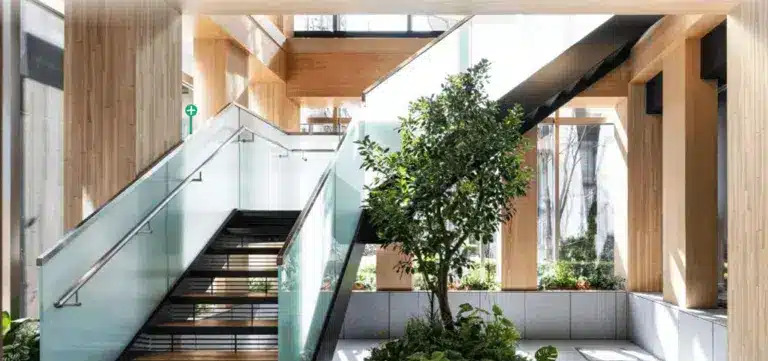
But it’s not just about creating a stunning workspace. It’s also about doing it in a way that respects and protects nature. Its extensive use of timber, especially on the first and second floors and in the building’s columns and beams, makes it stand out.
Sumitomo Forestry Co. provided these components, ensuring they meet the strict SGEC chain of custody standards. This means every piece of forest-based material used in the building can be traced back to its origins.
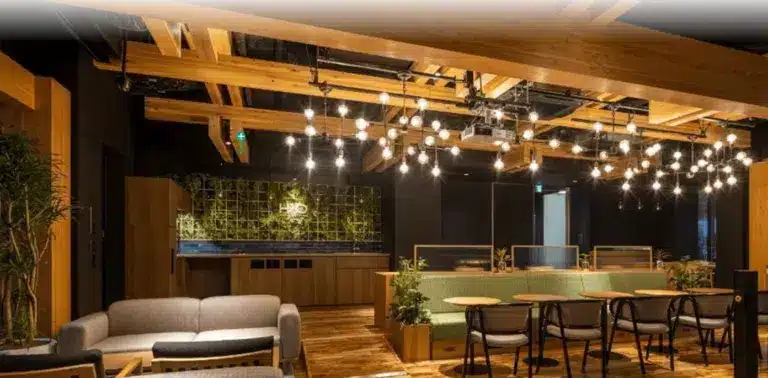
As a result, the project has gained a PEFC chain of custody certification, the highest possible accreditation in this domain.
With the primary objective of combining wellness at work with sustainable building practices, the building specifications met Japanese green building and energy rating schemes that met various design and performance standards, including CASBEE and BELS.
Looking to replicate the results of surveys showing increased happiness, productivity and creativity in office spaces where people encounter nature, H10 Chayamachi invests heavily in curating thoughtful tactile spaces for their customers to get closer to nature.
Undoubtedly, forests, the lungs of our planet, are vital for our environment and improve our health andwell-beingg.
Who doesn’t feel better after a quiet walk in the woods?
But what if we could bring those benefits into our daily spaces, like our homes and offices?
Could buildings thoughtfully made with materials that stay true to their natural roots, like wood, offer the same perks?
Scientific research has started to confirm what forest bathers have long known, that we can bring many of these benefits into our daily spaces with thoughtfully constructed buildings made from materials close to their natural state, such as wood.
Stepping out into the great outdoors is a wonderful break, but most of our time is spent indoors.
As the philosopher of architecture, Gaston Bachelard, suggests, every space we inhabit for a significant amount of time has a touch of ‘home’ about it.
While no building could replace the natural environment, the materials with which we create our living spaces are at the core of our lives.
Connecting us as closely as possible to nature is the mission of biophilic architecture. This design principle aims to join us in the natural world by incorporating elements of nature.
As resources become increasingly limited and needs grow, several progressive cities are gearing up to strengthen their ties with nature.
Biophilic Cities, a network of cities joined in the mission to infuse urban landscapes with more nature, champions the cause of integrating natural elements to improve urban living.
With thirty cities worldwide now on board, they’re leading the way towards a future where city-dwellers’ health and andwell-beingg are seamlessly intertwined with practices that nurture and sustain both people and the environment.
These exemplary buildings show how, with certification and innovative design approaches, wooden construction can be sustainably accomplished and, perhaps, help us reconnect with nature.





